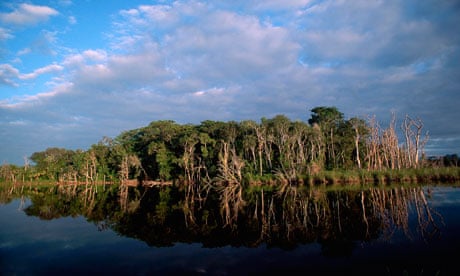There are cows as far as the eye can see beside the road leading to the archaeological site of La Joyanca, in north-west Guatemala. Over the last 10 years, the primal forest has been cut down, replaced by grassland for intensive cattle farming. Here in the Petén region, around as well as inside the Laguna del Tigre National Park, agriculture is inexorably devouring the forest.
The process has been triggered incrementally in a series of seemingly minor steps. "At the end of the 1980s, when this zone was not yet a national park, Basic Petroleum obtained an oil exploration concession in the Laguna del Tigre area, in the heart of the forest," said Marco Cerezo, a Guatemalan environmentalist who founded FundaEco, a leading NGO dedicated to nature conservation and development. "Later, the oil companies asked for, and obtained, permission to build a road to their oil wells. And that is where the land clearing started, all along that road. Now approximately 40% of the national park has been cleared."
The same thing is happening across the Petén region, which extends across the northern half of the country to the border with Belize and Mexico. According to the latest report from the UN Food and Agriculture Organisation (FAO) published at the end of 2010, Guatemala has experienced the most rapid deforestation of any country over the last five years.
In 2010, primary forest accounted for 1.6m hectares, compared with 2.4m 20 years earlier. Guatemala, which, after Brazil, has South America's second-largest rainforest cover, lost an average of 27,000 hectares a year between 2000 and 2005 (a rate of 1.32% per year), increasing to 68,000 hectares a year between 2005 and 2010 (3.72% per year), meaning that the rate of deforestation has almost trebled in the course of a decade.
It is driven by two factors, explains geographer Gilles Selleron: "Thanks to satellite imagery we can distinguish between the cattle rearing, which is mainly carried by the Ladino population, people of Hispanic origin, and the traditional subsistence farming of corn, marrow and beans by the indigenous Q'eqchi, a Maya people." Selleron, who is based at the French national research institute and the environmental geography unit at Toulouse University, is a specialist in forest dynamics.
Demographic pressure does not explain the speed with which the agricultural and grazing frontier has advanced. Nor why small farmers are pushing their way deeper and deeper into the forest.
According to Cerezo, recent trade negotiations have allowed Guatemala to increase sugar exports, so sugar cane plantations have expanded. This competition for the land in a country that has never implemented agricultural reforms is occurring at the expense of local communities, which are being forced to search for new land.
But that's not all. "In the last five years, the biggest contribution to the rapid deforestation has been the massive increase in demand for palm oil and the narcofincas or narco-farms," said Cerezo.
Agro-forestry NGOs in the field are also coming across a new pressure: land appropriation by drug traffickers by forced purchase or illegally felling trees in protected areas. "The drug barons are trying to acquire a social status with land and cattle ownership," explains Cerezo. "They're setting up a new type of feudalism, with thousands of hectares being turned over to intensive cattle farming."
And if the sugar cane, palm oil and narco-farms were not enough, open-cast mines are also competing for land. These pressures combine to push small communities deeper into the forest. In Guatemala, one of the poorest and most corrupt countries in Latin America, Cerezo believes the forest has become the focus for the tensions running through society.
For Selleron, the erosion of the forest should also be seen in historical perspective and points to the fact that forest coverage has ebbed and flowed. "You have to remember that 2,000 years ago the peak of the Mayan civilisation was achieved by clearing the forest, which was considerably reduced at the time," explained the geographer. "During the Classic Maya period, between AD200 and AD900, the population density in what is now Petén was approximately 200 inhabitants per square kilometre, compared with fewer than a dozen today. They were obliged to clear the land and cultivate it to feed that population."
But another factor now also plays a part, climate change. "In the 1990s, the environmental NGOs saw the forest as a reservoir of diversity to be preserved," explained Cerezo, "but now it's perceived more as a way of attenuating the effects of climate change." In the last two decades there have been far more episodes of heavy rainfall, which, coupled with deforestation in this mountainous land, has led to disastrous mudslides.
Despite the difficult outlook for Guatemala's primal forests, NGOs are not giving up. Discussions are under way with the French banking group BNP Paribas to use carbon compensation schemes to fund forest management.
This story originally appeared in Le Monde
